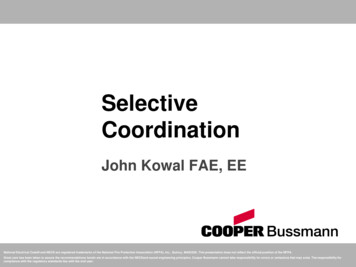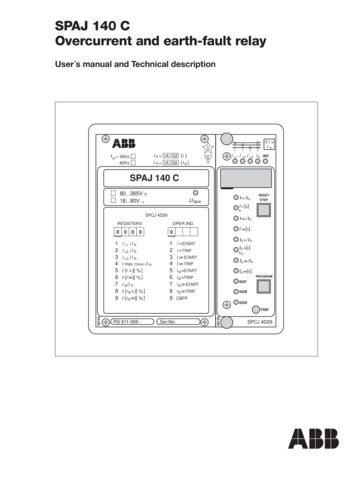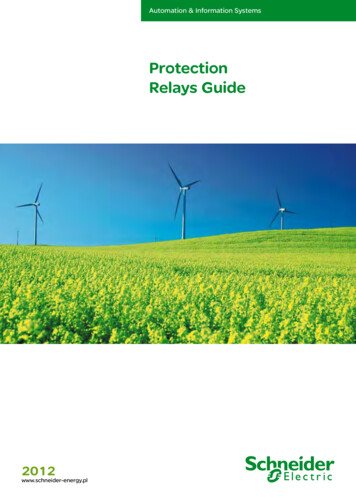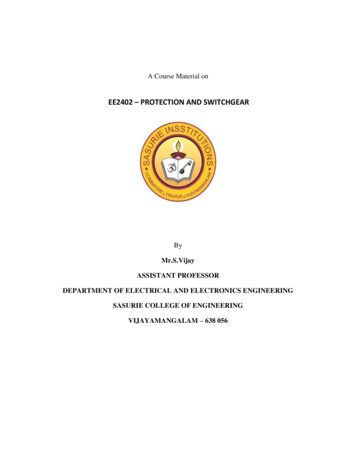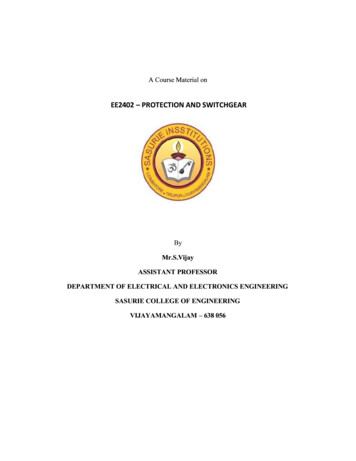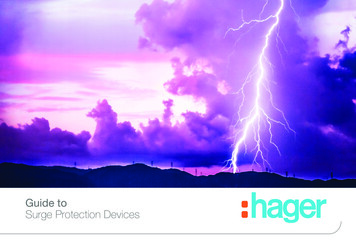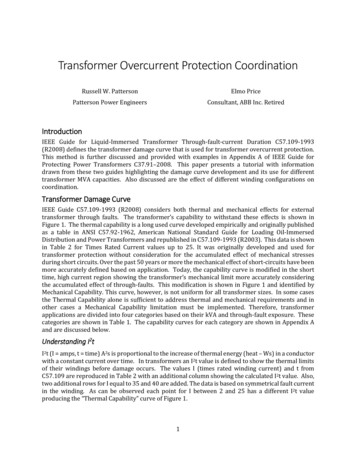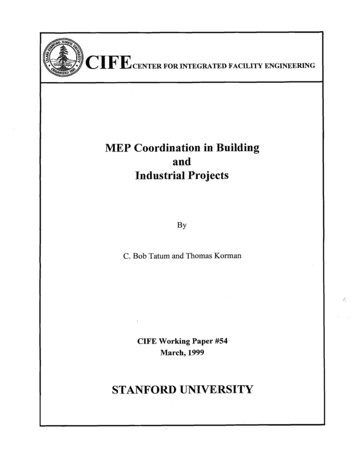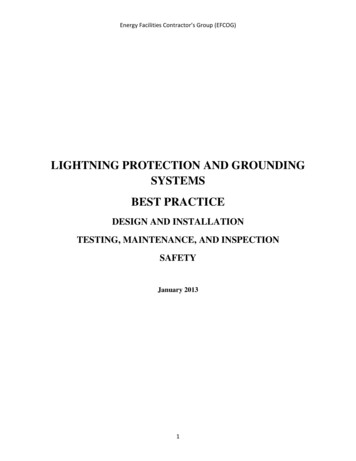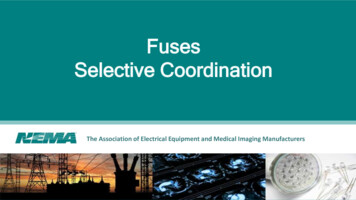
Transcription
FusesSelective CoordinationThe Association of Electrical Equipment and Medical Imaging Manufacturers
The Association of Electrical andMedical Imaging Equipment ManufacturersScopeThis presentation provides informationfor proper application of fuses whenselective coordination is either desiredfor design or required by code2
The Association of Electrical andMedical Imaging Equipment ManufacturersGoals Understand key terms related to selective coordination Understand where selective coordination is required by Code andwhere it can be a design goal Discern the difference between a “selectively coordinated” systemand a “coordinated” system Understand the impact of fault current to selective coordination Determine how to achieve selective coordination with fuses3
Selective CoordinationA Design GoalThe Association of Electrical Equipment and Medical Imaging Manufacturers
The Association of Electrical andMedical Imaging Equipment ManufacturersBenefits of selective coordination Minimize risk of power loss to life safety systems, such asemergency lighting, fire detection, elevators, and others. Minimize risk of costly downtime, such as is necessary forIT equipment or continuous process manufacturingoperations. Faster location and resolution of fault on the system due toisolation (closes OCPD to the fault opens)5
The Association of Electrical andMedical Imaging Equipment ManufacturersLife Safety Requirements Power is Important For Life Safety LightsFire PumpsHVACSecurityCommunicationsVisual and Audible SignalingReliable Power Systems Are Important For Life Safety6
The Association of Electrical andMedical Imaging Equipment ManufacturersContinuity of Service Power is Important For Continuity of Service ComputersManufacturing EquipmentData Storage SystemsOffice General LightingBroadcast EquipmentMeeting Room EssentialsReliable Power Systems Are ImportantFor Business Profitability7
The Association of Electrical andMedical Imaging Equipment ManufacturersThe Design GoalReliability in Refining and Petrochem facilities Unplanned outages can cost M in lost production, lostproductivity, damaged equipment. Average downtime cost 704,000 USD per hour.A 100 MW petro-chemical plant produces approximately 2 billion per year in revenues– or 228,000 per hour. With an average of 8 hours of downtime per year, an average100 MW plant will lose over 1.8 million in revenue annually to electrical systemoutages8
The Association of Electrical andMedical Imaging Equipment ManufacturersGrocery Store Value Proposition Florida's largest supermarket chain has created its own initiative tomake sure its stores can open after a hurricane. Publix is spending 100 million to install 500 kilowatt generators at every store inhurricane prone areas. In 2004 alone, Publix lost 60 million from groceries that went badafter hurricanes knocked out power to its stores.9
The Association of Electrical andMedical Imaging Equipment ManufacturersGrocery Store Value Proposition More than 100 South Florida supermarkets now are equipped withstationary generators large enough to restore them to business asusual, fresh and frozen food aisles included, during poweroutages. Most were installed after Hurricane Wilma hit in 2005.The storm left residents frustrated by long lines and limited foodselections when dozens of grocery stores had no power for days.10
DefinitionsThe Association of Electrical Equipment and Medical Imaging Manufacturers
The Association of Electrical andMedical Imaging Equipment ManufacturersDefinitions Fault Current Fault Current, Available Coordination, Selective (SelectiveCoordination)12
DefinitionsFault CurrentThe Association of Electrical Equipment and Medical Imaging Manufacturers
Article 100 Fault Current New definition in Article 100 for NEC 2020 Part of a Correlating Committee taskforce toaddress correlation with NFPA 70E recentchanges Aligns the use of the terms Short-Circuitcurrent and available fault current
Article 100 Fault CurrentFault CurrentThe current delivered at a point on the systemduring a short-circuit condition. (CMP-10)
DefinitionsFault Current, Available(Available Fault Current)The Association of Electrical Equipment and Medical Imaging Manufacturers
The Association of Electrical andMedical Imaging Equipment ManufacturersFault Current, Available (Available Fault Current) New definition for NEC 2020 Replaces “maximum available shortcircuit current” where used in the NEC Aligns with NFPA 70E recent changes inuse of the same term17
The Association of Electrical andMedical Imaging Equipment Manufacturers100 Fault Current, AvailableThe largest amount of current capable of beingdelivered at a point on the system during ashort-circuit condition. (CMP-10)Informational note: A short-circuit can occurduring abnormal conditions such as a faultbetween circuit conductors or a ground-fault.See Informational Note Figure 100.118
The Association of Electrical andMedical Imaging Equipment ManufacturersFault Current, Available (Available Fault Current)Ac or dc supply sourceSourceNew DiagramAvailable fault currentAvailable fault currentEquipmentOCPD with anInterrupting RatingOCPDAvailable fault currentEquipment with a SCCRLoad19
The Association of Electrical andMedical Imaging Equipment ManufacturersAvailable Fault Current Maximum current is used to evaluate: Interrupting ratings of OCPDs SCCR ratings of equipment Selective Coordination of OCPDs20
The Association of Electrical andMedical Imaging Equipment ManufacturersAvailable Fault Current Rarely occur in power distribution systems Commonly associated with first startupafter installation or maintenance activities Forgetting to remove shipping straps Forgetting to remove intentional grounding formaintenance21
The Association of Electrical andMedical Imaging Equipment Manufacturers110.9 Interrupting Rating NEC Requires: OCPDs interrupt fault current and must have aninterrupting rating, at nominal circuit voltage, equal toor greater than the current that is available at the lineterminals of the equipment Installers and inspectors must ensure theinterrupting rating of the OCPD is greater thanor equal to the available fault current22
The Association of Electrical andMedical Imaging Equipment ManufacturersFuse applications Fuses are capable of 200kA and higherinterrupting ratings For systems not capable of delivering200kA, applying 200kA fuses removesthe need for detailed fault currentcalculations for the purpose ofinterrupting rating evaluation23
The Association of Electrical andMedical Imaging Equipment Manufacturers110.10 Circuit Impedance, Short-Circuit CurrentRatings, and Other Characteristics NEC Requires: Equipment must have a short-circuit currentrating (SCCR) equal to or greater than thecurrent that is available at the line terminalsof the equipment24
The Association of Electrical andMedical Imaging Equipment ManufacturersShort-Circuit Current Rating (SCCR) The ability of equipment to withstand magneticforces and thermal heating of high faultcurrents passing through the equipment untilan OCPD clears the fault This is NOT an interrupting rating SCCR must be greater than or equal tomaximum fault current25
DefinitionsCoordination, Selective(Selective Coordination)The Association of Electrical Equipment and Medical Imaging Manufacturers
The Association of Electrical andMedical Imaging Equipment ManufacturersSelective Coordination Selective coordination has beenin the vocabulary of the powersystems engineer for decadesNormalSource Goal is to minimize systemoutages & increase reliability Minimizes system down time Fault location on system is moreClosed OCPDefficientPanelOpened OCPDDe-Energized27
The Association of Electrical andMedical Imaging Equipment ManufacturersCoordination, Selective (Selective Coordination)“Localization of an overcurrent condition to restrictoutages to the circuit or equipment affected, accomplishedby the selection and installation of overcurrent protectivedevices and their ratings or settings for the full range ofavailable overcurrents, from overload to the maximumavailable fault current, and for the full range of overcurrentprotective device opening times associated with thoseovercurrents.”2020 Version NFPA 70, National Electrical Code, Article 100 Definitions28
The Association of Electrical andMedical Imaging Equipment ManufacturersCoordination, Selective (Selective Coordination)“Localization of an overcurrent conditionto restrict outages to the circuit orequipment affected. . .” The OCPD Closest To The FaultOpens Branch Circuit Fault Opens TheClosest Branch Circuit OCPDNormalSourcePanelClosed OCPDOpened OCPDDe-Energized29
The Association of Electrical andMedical Imaging Equipment ManufacturersCoordination, Selective (Selective Coordination)“Localization of an overcurrent conditionto restrict outages to the circuit orequipment affected. . .” The OCPD closest to the fault opens Faulted feeder opens the first feederOCPD Outage to downstream equipmentonlyNormalSourcePanelClosed OCPDOpened OCPDDe-Energized30
The Association of Electrical andMedical Imaging Equipment ManufacturersA lack of selective coordination“Localization of an overcurrent conditionto restrict outages to the circuit orequipment affected. . .”NormalSource Multiple OCPDs Open Due ToThe Fault Wide Spread System Outage IsCausedClosed OCPDPanelOpened OCPDDe-Energized31
The Association of Electrical andMedical Imaging Equipment ManufacturersA lack of selective coordination Main OCPD Opens Due To TheFaultNormalSource Wide Spread System Outage IsCaused Main OCPDs Have Been KnownTo Open Because of A Lack OfSelective CoordinationClosed OCPDPanelOpened OCPDDe-Energized32
The Association of Electrical andMedical Imaging Equipment ManufacturersSelective Coordination – Article 100“Localization of an overcurrent condition to restrictoutages to the circuit or equipment affected, accomplishedby the selection and installation of overcurrent protectivedevices and their ratings or settings for the full range ofavailable overcurrents, from overload to the maximumavailable fault current, and for the full range of overcurrentprotective device opening times associated with thoseovercurrents.”2017 Version NFPA 70, National Electrical Code, Article 100 Definitions33
“As selectivity and maximum safety to personnel are critical, engineers shouldalways perform a total short-circuit, coordination, and component protectionstudy for a project. This study first determines the available short-circuitcurrents at each major component throughout the system. Then it will includetime vs. current coordination curves to be drawn and to coordinate timeintervals to determine if the overcurrent devices are selectively coordinated atthe various available fault currents. Then the study will examine the componentwithstand ratings to ensure that the device can actually protect the componentsat the fault current levels that may be present during a fault.”IEEE Std. 602-2007, “Electric Systems in Health Care Facilities” Page 113Selective Coordination At Various Available Fault Currents Should BeAchieved – Life Safety
The Association of Electrical andMedical Imaging Equipment ManufacturersThe TCC curveTime (Seconds) The TCC plots time versuscurrent Log-log paper to enableplotting of tripcharacteristicsCurrent (Amps)35
The Association of Electrical andMedical Imaging Equipment ManufacturersThe TCC curve The TCC curve providesinformation as to how the fusewill respond to current8 4,000A flowing through this fusewill open it anywhere between2 & 8 seconds Be aware of the scale (Currentin amps X 10)24,000 Amps36
The Association of Electrical andMedical Imaging Equipment ManufacturersSelective Coordination The TCC curve provides information asto how the fuse will respond to current 700A flowing through both fuses Fuse A maximum clearing time is 0.23seconds Fuse B Minimum melt time is3.0 seconds These devices are selectivelycoordinated at 700AAClass J 60AClass J 100AIscBBA3.00.23700A37
The Association of Electrical andMedical Imaging Equipment ManufacturersTCC curve 4000A flowing through bothfusesAClass J 60AClass J 100AIscBB Based on the TCC selectivecoordination is NOT achieved Fuse ratio tables provide tested datato determine selectivityA4000A38
The Association of Electrical andMedical Imaging Equipment ManufacturersTCC curve Class J fuses must maintain aratio of 2:1 for selectivityAClass J 60AClass J 100AIscB Ratio of upstream to downstream fuses This example ratio 100/60 2:1 soselective coordination is NOT achieved Upstream fuse must be 120A orgreater to selectively coordinate forALL fault currents up to 200kABA4000A39
The Association of Electrical andMedical Imaging Equipment ManufacturersSelective Coordination - Fuse Example system – two Class J fusesthat must selectively coordinateIsc600AClass J600 Amps Fuse curves MAY be plotted Maintaining a ratio of 2:1 for thesefuses ensures selective coordinationfor all currents up to 200kA“. . . from overload to the maximumavailable fault current, and for the fullrange of overcurrent protective deviceopening times . . .”Class J300 Amps300AIsc AmpsAllCurrents40
The Association of Electrical andMedical Imaging Equipment ManufacturersSelective Coordination - Fuse800A400A100AOverloads or faults of any levelup to200,000AMaintain a 2:1 Ratio forthese Class fuses800/400 2:1 only 2:1 neededSelective Coordination achieved400/100 4:1 only 2:1 neededSelective Coordination achievedbetween these two fuses4141
Selective CoordinationNEC RequirementsThe Association of Electrical Equipment and Medical Imaging Manufacturers
The Association of Electrical andMedical Imaging Equipment ManufacturersNational Electrical Code RequirementsArt100TitleDefinitionsNEC20051975 GF2005 “Selective”2014 “Coordination”517Healthcare Facilities620Elevators, Dumbwaiters, Escalators, Moving Walks, Wheel Chair Lifts, and Stairway ChairLifts1993645Information Technology Equipment2014695Fire Pumps2011700Emergency Systems2005701Legally Required Standby Systems2005708Critical Operations Power Systems (COPS)200843
The Association of Electrical andMedical Imaging Equipment ManufacturersNFPA 70 NEC 2017 RequirementsArticle 517 Health Care Facilities517.17Ground-Fault ProtectionArticle 620 Elevators, Dumbwaiters,Escalators, Moving Walks, Platform Lifts, andStairway Chairlifts620.62Selective CoordinationArticle 645 Information TechnologyEquipment645.27Selective CoordinationArticle 700 Emergency Systems700.32Selective CoordinationArticle 701 Legally Required StandbySystems701.27Selective CoordinationArticle 708 Critical Operations PowerSystems (COPS)708.52708.54Ground-Fault Protection of EquipmentSelective CoordinationArticle 695 Fire Pumps695.3Power Source(s) for Electric Motor-DrivenFire Pumps.44
The Association of Electrical andMedical Imaging Equipment ManufacturersArticle 517 – Health Care Facilities517.17 Ground-Fault Protection.(C) Selectivity. Ground-fault protection for operation of the service and feederdisconnecting means shall be fully selective such that the feeder device, but not theservice device, shall open on ground faults on the load side of the feeder device.Separation of ground-fault protection time-current characteristics shall conform tomanufacturer’s recommendations and shall consider all required tolerances anddisconnect operating time to achieve 100 percent selectivity.45
The Association of Electrical andMedical Imaging Equipment ManufacturersArticle 620 – Elevators, Dumbwaiters, Escalators,Moving Walks, Platform & Stairway Chairlifts620.62 Selective Coordination. Where more than one driving machine disconnectingmeans is supplied by a single feeder, the overcurrent protective devices in eachdisconnecting means shall be selectively coordinated with any other supply sideovercurrent protective devices.Selective coordination shall be selected by a licensed professional engineer or otherqualified person engaged primarily in the design, installation, or maintenance ofelectrical systems. The selection shall be documented and made available to thoseauthorized to design, install, inspect, maintain, and operate the system.46
The Association of Electrical andMedical Imaging Equipment ManufacturersArticle 645 – Modular Data Centers645.27 Selective Coordination. Critical operations data system(s) overcurrent protectivedevices shall be selectively coordinated with all supply-side overcurrent protectivedevices.47
The Association of Electrical andMedical Imaging Equipment ManufacturersArticle 695 – Fire Pumps695.3 Power Source(s) for Electric Motor-Driven Fire Pumps. Electric motor-driven fire pumps shallhave a reliable source of power.(A) Individual Sources. . . .(B) Multiple Sources. . . .(C) Multibuilding Campus-Style Complexes.If the sources in 695.3(A) are not practicable and the installation is part of a multibuilding campusstyle complex, feeder sources shall be permitted if approved by the authority having jurisdiction andinstalled in accordance with either (C)(1) and (C)(3) or (C)(2) and (C)(3).(1) Feeder Sources. . . .(2) Feeder and Alternate Source. . . .(3) Selective Coordination. The overcurrent protective device(s) in each disconnectingmeans shall be selectively coordinated with any other supply-side overcurrent protectivedevice(s).48
The Association of Electrical andMedical Imaging Equipment ManufacturersArticle 700 – Emergency Systems700.32 Selective Coordination.Emergency system(s) overcurrent devices shall be selectively coordinated with allsupply-side overcurrent protective devices.Selective coordination shall be selected by a licensed professional engineer or otherqualified persons engaged primarily in the design, installation, or maintenance ofelectrical systems. The selection shall be documented and made available to thoseauthorized to design, install, inspect, maintain, and operate the system.Exception: Selective coordination shall not be required between two overcurrentdevices located in series if no loads are connected in parallel with the downstreamdevice.49
The Association of Electrical andMedical Imaging Equipment ManufacturersArticle 701 – Legally Required Standby Systems701.27 Selective Coordination.Legally required standby system(s) overcurrent devices shall be selectively coordinatedwith all supply-side overcurrent protective devices.Selective coordination shall be selected by a licensed professional engineer or otherqualified persons engaged primarily in the design, installation, or maintenance ofelectrical systems. The selection shall be documented and made available to thoseauthorized to design, install, inspect, maintain, and operate the system.Exception: Selective coordination shall not be required between two overcurrent deviceslocated in series if no loads are connected in parallel with the downstream device.50
The Association of Electrical andMedical Imaging Equipment ManufacturersArticle 708 – Critical Operations Power Systems708.54 Selective Coordination.Critical operations power system(s) overcurrent devices shall be selectively coordinatedwith all supply-side overcurrent protective devices.Selective coordination shall be selected by a licensed professional engineer or otherqualified persons engaged primarily in the design, installation, or maintenance ofelectrical systems. The selection shall be documented and made available to thoseauthorized to design, install, inspect, maintain, and operate the system.Exception: Selective coordination shall not be required between two overcurrentdevices located in series if no loads are connected in parallel with the downstreamdevice.51
Selective CoordinationExceptionsThe Association of Electrical Equipment and Medical Imaging Manufacturers
The Association of Electrical andMedical Imaging Equipment ManufacturersSelective Coordination Requirements“Exception: Selectivecoordination shall not berequired between twoovercurrent devices locatedin series if no loads areconnected in parallel withthe downstream device.”AB53
The Association of Electrical andMedical Imaging Equipment ManufacturersSelective Coordination RequirementsBranch devices “A” mustselectively coordinate withdevices “B” and “C”.CBA54
The Association of Electrical andMedical Imaging Equipment ManufacturersSelective Coordination Requirements“Exception: Selectivecoordination shall not berequired between twoovercurrent devices locatedin series if no loads areconnected in parallel withthe downstream device.”CBA55
The Association of Electrical andMedical Imaging Equipment ManufacturersAll supply-side overcurrent devicesNEC requirements are consistent in all areas ofthe NEC mandating selective coordination thatdevices must selectively coordinate with allsupply-side overcurrent protective devices.NEC 2020 added an informational note to 700.32,701.32, and 708.54 to clarify what devices mustselectively coordinate56
The Association of Electrical andMedical Imaging Equipment ManufacturersSelective CoordinationRequirements 700, 701 and 708 powersystem overcurrentdevicesUtilityGAEBF OCPDs on Emergencyside of transfer switchCD57
The Association of Electrical andMedical Imaging Equipment ManufacturersUtilitySelective CoordinationRequirements 700, 701 and 708 powersystem overcurrent devicesGAEBF Devices On The NormalPower Supply SystemCD58
The Association of Electrical andMedical Imaging Equipment ManufacturersSelective CoordinationRequirements 700, 701, and 708 OCPDs must selectivelycoordinate with all upstream overcurrentprotective devices: D must Selectively Coordinate with C,F, E, B and A C must Selectively Coordinate with F,E, B and A F must selectively Coordinate with E OCPDs A and B do not have to selectivelycoordinate with each otherUtilityGAEBFCD59
The Association of Electrical andMedical Imaging Equipment ManufacturersSelective CoordinationRequirements 700, 701, and 708 OCPDs must selectivelycoordinate with all upstream overcurrentprotective devices: D must Selectively Coordinate with C,F, E, B and A C must Selectively Coordinate with F,E, B and A F must selectively Coordinate with E OCPDs A and B do not have to selectivelycoordinate with each otherUtilityGAEBFCD60
The Association of Electrical andMedical Imaging Equipment ManufacturersSelective CoordinationRequirements 700, 701, and 708 OCPDs must selectivelycoordinate with all upstream overcurrentprotective devices: D must Selectively Coordinate with C,F, E, B and A C must Selectively Coordinate with F,E, B and A F must selectively Coordinate with E OCPDs A and B do not have to selectivelycoordinate with each otherUtilityGAEBFCD61
The Association of Electrical andMedical Imaging Equipment ManufacturersSelective CoordinationRequirements 700, 701, and 708 OCPDs must selectivelycoordinate with all upstream overcurrentprotective devices: D must Selectively Coordinate with C,F, E, B and A C must Selectively Coordinate with F,E, B and A F must selectively Coordinate with E OCPDs A and B do not have to selectivelycoordinate with each otherUtilityGAEBFCD62
The Association of Electrical andMedical Imaging Equipment ManufacturersCoordination vs. Selective Coordination Selective coordination is not the same ascoordination as required in 517.30(G)63
The Association of Electrical andMedical Imaging Equipment ManufacturersNEC Article 517 - Coordination517.30(G) Coordination. Overcurrent protective devices serving the essential electrical systemshall be coordinated for the period of time that a fault’s duration extends beyond 0.1 second.Exception No. 1: Between transformer primary and secondary overcurrent protective devices,where only one overcurrent protective device or set of overcurrent protective devices exists onthe transformer secondary.Exception No. 2: Between overcurrent protective devices of the same size (ampere rating) inseries.Informational Note: The terms coordination and coordinated as used in this section do not coverthe full range of overcurrent conditions.64
The Association of Electrical andMedical Imaging Equipment ManufacturersCoordination Definition - NEMALocalization of an overcurrent condition to minimize outages to thecircuit or equipment affected, accomplished by the selection andinstallation of overcurrent protective devices and their ratings orsettings, ensuring separation of their time current curves beyond aspecified time period without regard to fault current magnitude or belowa specified level of fault current less than the maximum available kers.aspx#download65
Article 517 CoordinationThe Association of Electrical Equipment and Medical Imaging Manufacturers
The Association of Electrical andMedical Imaging Equipment ManufacturersNEC Article 517 CoordinationThis TCC CurveShows A Pair Of fusesThat Both See4,000Amps of FaultCurrent21Isc124000A1Class J 100A2Class RK5 50A67
The Association of Electrical andMedical Imaging Equipment ManufacturersNEC Article 517 Coordination21Isc“. . . Separation of their timecurrent curves .”12 Separation of time currentcurves looks for spacebetween curves4000A Overlap in this exampleillustrates no separation1Class J 100A2Class RK5 50A68
The Association of Electrical andMedical Imaging Equipment ManufacturersNEC Article 517 Coordination21Isc1“. . . separation of their time currentcurves beyond a specified time period . .” Separation of curves for times 0.1seconds Overlaps for times 0.1 seconds areignored24000A0.1 Second Tool69
The Association of Electrical andMedical Imaging Equipment ManufacturersNEC Article 517 Coordination“. . . separation of their time currentcurves beyond a specified time periodwithout regard to fault current magnitude” Disregard Calculated Maximum IscCurrent “Informational Note: The termscoordination and coordinated as usedin this section do not cover the fullrange of overcurrent conditions.”(NEC 2014 change)21Isc1Coordinated24000A0.1 Second Tool70
The Association of Electrical andMedical Imaging Equipment ManufacturersNEC Article 517 Coordination517.31(G) Coordination. Overcurrent protective devices serving theessential electrical system shall be coordinated for the period of timethat a fault’s duration extends beyond 0.1 second.21Isc1CoordinatedException No. 1: Between transformer primary and secondaryovercurrent protective devices, where only one overcurrent protectivedevice or set of overcurrent protective devices exists on thetransformer secondary.2Exception No. 2: Between overcurrent protective devices of the samesize (ampere rating) in series.4000AInformational Note: The terms coordination and coordinatedas used in this section do not cover the full range ofovercurrent conditions.0.1 Second Tool71
The Association of Electrical andMedical Imaging Equipment ManufacturersNEC Article 517 - Coordination Selectively Coordinated fuses Will exceedcoordination requirements found in Article 517(0.1 Seconds) Coordinated fuses May Not Selectively Coordinateto maximum available fault current Fuses that achieve selective coordination exceedthe performance of a coordinated system72
The Association of Electrical andMedical Imaging Equipment ManufacturersTypical Selective Coordination Process Short circuit study Equipment Evaluation Selective CoordinationEvaluation73
Selective Coordination SpecificationsThe Association of Electrical Equipment and Medical Imaging Manufacturers
The Association of Electrical andMedical Imaging Equipment ManufacturersClarity in specifications is important for all involved Consultant creates a specification Contractors work with distributors and manufacturersto quote the system seeking value engineeringopportunities that could jeopardize selectivity Series rated solutions may selected whichcompromises selective coordination goalsSpecifications must be clear and specific to ensure what theconsultant expects is what is quoted75
The Association of Electrical andMedical Imaging Equipment ManufacturersExamples of Selective Coordination SpecLanguageA Nationally used specification service260573 - OVERCURRENT PROTECTIVE DEVICE COORDINATION STUDYGraphic illustration may or may not provide enough information for selectivecoordination.Need for clear specification language76
The Association of Electrical andMedical Imaging Equipment ManufacturersExamples of Selective CoordinationSpec LanguageA Nationally used specification serviceDoes 0.01 mean “Selective Coordination”? Does this meet NEC definition of selectivecoordination? Does this meet design goals?Need for clear specification language77
The Association of Electrical andMedical Imaging Equipment ManufacturersExamples of Selective CoordinationSpec LanguageA Nationally used specification serviceTerms 0.1 and “Selective Coordination” contradict one another. Moreinformation is needed to determine if this is an Article 700, 701, 708 or othertype of system requiring selective coordination.Need for clear specification language78
The Association of Electrical andMedical Imaging Equipment ManufacturersSuggested Specification Language – SelectiveCoordination Those portions of this design that specify selective coordination, or arerequired by the National Electrical Code to selectively coordinate, areintended to localize the impact of an overcurrent condition thus restrictingoutages to the circuit or equipment affected and shall meet the following: a. Overcurrent protective devices must selectively coordinate for the fullrange of available overcurrents, from overload to the maximum availablefault current, and for the full range of overcurrent protective deviceopening times asso
Closed OCPD Panel Opened OCPD De-Energized 30. The Association of Electrical and Medical Imaging Equipment Manufacturers A lack of selective coordination “Localization of an overcurrent condition to restrict outages to the circuit or equipment affected. . .” Multiple O
